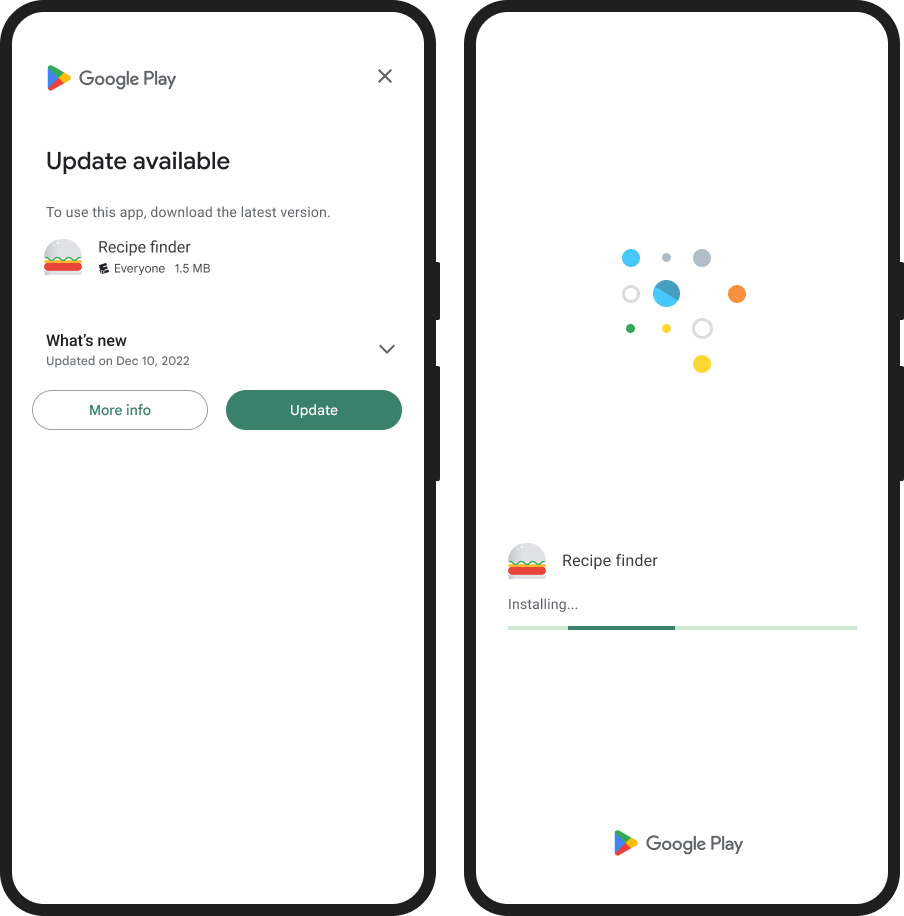当用户设备上安装的是最新版的应用时,他们可以试用新功能,并从性能提升和问题修复中获益。虽然一些用户会在设备连接到不按流量计费的连接时启用后台更新,但还有一些用户可能需要收到提醒来决定是否安装更新。应用内更新是 Google Play Core 库的一项功能,用于提示活跃用户更新应用。
应用内更新功能适用于搭载 Android 5.0(API 级别 21)或更高版本的设备。此外,只有 Android 移动设备、Android 平板电脑以及 ChromeOS 设备支持应用内更新。
更新流程
您的应用可以使用 Google Play Core 库支持以下针对应用内更新的用户体验流程:
灵活更新
灵活更新提供后台下载和安装,同时妥善监控状态。如果让用户可以在下载更新的同时使用应用,这种用户体验流程非常合适。例如,您可能希望鼓励用户试用对应用的核心功能而言并不是至关重要的新功能。

图 1. 灵活更新流程示例。
立即更新
立即更新属于全屏用户体验流程,要求用户更新并重启应用才能继续使用应用。如果更新对应用的核心功能至关重要,这种用户体验流程最为合适。用户接受立即更新后,Google Play 会处理更新安装和应用重启。

图 2. 立即更新流程示例。
在您的应用中支持应用内更新
了解如何根据您的开发环境在应用中支持应用内更新:
服务条款
访问或使用 Play 应用内更新库即表示您同意接受 Play Core 软件开发套件服务条款。请先阅读并了解所有适用的条款及政策,然后再访问该库。
数据安全
Play Core 库是您的应用与 Google Play 商店的运行时接口。因此,当您在应用中使用 Play Core 时,Play 商店会运行自己的进程,其中包括处理受 Google Play 服务条款约束的数据。以下信息说明了 Play Core 库如何通过处理数据来处理从您的应用发来的特定请求。
应用内更新
| 收集的使用情况数据 |
设备元数据 应用版本 已安装模块和资源包的列表 |
| 数据收集目的 | 我们会利用收集的数据来确定是否有可用的更新,以及更新的预计大小。 |
| 数据加密 | 数据会加密。 |
| 数据分享 | 我们不会将收集的数据发送给任何第三方。 |
| 数据删除 | 我们会在固定保留期限过后删除收集的数据。 |
虽然我们力求做到尽可能公开透明,但对于 Google Play 的“数据安全”部分针对您的应用的用户数据收集、分享和安全做法提供的表单,您需自行负责决定如何回应。

